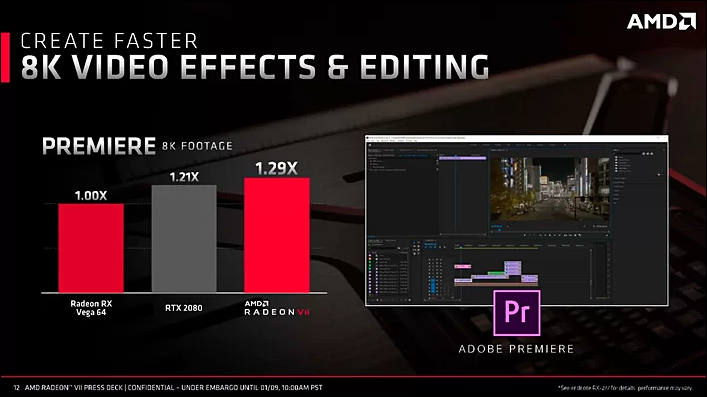
-
Lot of high speed HBM memory - 16GB, nice calc performance.
-
PR
AMD (NASDAQ: AMD) today unveiled AMD Radeon™ VII, the world's first 7nm gaming graphics card. It was designed to deliver exceptional performance and amazing experiences for the latest AAA, esports and Virtual Reality (VR) titles, demanding 3D rendering and video editing applications, and next-generation compute workloads.
Built on the enhanced second-generation AMD 'Vega' architecture, AMD Radeon VII provides 2X the memory, 2.1X the memory bandwidth, up to 29 percent higher gaming performance on average, and up to 36 percent higher performance on average in content creation applications compared to the current top-of-the-line AMD Radeon™ RX Vega 64 graphics card1,2,3,4. For gamers, AMD Radeon VII enables maximum settings for extreme framerates at the highest resolutions. It also provides seamless, high-refresh HDR5 gaming at 1080p, ultrawide 1440p and 4K, and enables next-generation photo and visual creation applications on razor sharp, vibrant 8K monitors.
"AMD Radeon VII is the highest-performance gaming graphics card we ever created," said Scott Herkelman, corporate vice president and general manager, Radeon Technologies Group at AMD. "It is designed for gamers, creators and enthusiasts who demand ultra-high quality visuals, uncompromising performance and immersive gaming experiences."
Game Developers and Partners Embrace AMD Radeon VII
Leading game developers and partners are already embracing the incredible features, performance and experiences that the AMD Radeon VII graphics card provides. The Alienware Area 51 2nd Generation Threadripper™ Edition will now combine the new AMD Radeon VII graphics cards with 2nd Generation AMD Ryzen™ Threadripper™ processors to deliver powerhouse performance for superior gaming experiences in 4K. Also, the professional esports gaming team, Fnatic, will use AMD Radeon VII graphics cards in its high-performance gaming PCs for training and online competitions.
In addition, Ubisoft plans to bring AMD Radeon™ technologies to its upcoming AAA blockbuster, Tom Clancy's The Division® 2. The Division® 2will support the advanced features gamers demand including DirectX® 12 and support for AMD Radeon FreeSync™ 2 HDR technology6, as well as technologies such as shader intrinsics, rapid packed math, and asynchronous compute that help deliver superior gaming experiences.
"We've worked closely with AMD to take advantage of the latest next-generation AMD Radeon graphics features in the newest installment of The Division® series," said David Polfedt, managing director at Massive Entertainment. "The Division® 2 will leverage the performance and capabilities of the Radeon™ VII graphics card to deliver smooth and awe-inspiring visuals at 4K resolution, while letting players experience game-changing performance as they race to rescue Washington D.C. from the brink of collapse."
Built to unleash performance, enable extreme gaming, and drive the most demanding 3D rendering, video editing and compute applications, key features of the AMD Radeon VII graphics card include:
- Exceptional capabilities: The Radeon VII graphics card is built upon 7nm process technology, delivering higher gaming performance than the AMD Radeon™ RX Vega 64 graphics card3. Equipped with 60 compute units/3840 stream processors running at up to 1.8GHz and 16GB of ultra-fast HBM2 memory (second-generation High-Bandwidth Memory), the Radeon VII graphics card enables high-performance gaming and ultra-high quality visuals. Ground-breaking 1 TB/s memory bandwidth and a 4,096-bit memory interface paves the way for ultra-high resolution textures, hyper-realistic settings and life-like characters.
- Enabling real-time 3D and compute applications: The Radeon VII graphics card delivers the performance required for demanding 3D rendering and video editing applications, and next-generation compute workloads. It provides up to 27 percent higher performance in the popular open source 3D creation application Blender7, up to 27 percent higher performance in the professional video editing, color correction and visual effects application DaVinci Resolve 158, and up to 62 percent higher performance in the OpenCL™ LuxMark compute benchmark9 compared to the AMD Radeon RX Vega 64 graphics card.
- Extreme gaming performance: The AMD Radeon VII graphics card delivers exceptional performance in DirectX® 12- and Vulkan®-based games, including up to 35 percent higher performance in Battlefield™ V10, and up to 42 percent higher performance in Strange Brigade®11, compared to the AMD Radeon RX Vega 64 graphics card. It also delivers up to 25 percent higher performance in the widely popular esports title, Fortnite®.12
- Smooth gaming with Radeon FreeSync: With the high speeds of today's graphics cards, framerates often exceed the monitor refresh rate, causing stuttering and tearing. With AMD Radeon FreeSync13 technology, the popular, standards-based adaptive sync technology supported by more than 550 gaming monitors, gamers can experience smooth gameplay at every level. In addition, AMD Radeon FreeSync™ 2 HDR technology6 offers more than 2X better brightness and color volume compared to sRGB14.
- Unparalleled experiences with AMD Radeon software: AMDRadeon Software features Day-0 game driver support and up-to-the minute game optimizations for performance enhancements. Gamers can effortlessly capture, stream and share their memorable moments and clutch victories with Radeon™ ReLive; monitor performance and PC system info, and socialize with the AMD Link application; and fine-tune a range of settings to fit their needs with Radeon™ WattMan15 technology.
-
I really hope Puget Systems gives this card a chance in their suite of tests. I'm very interested to see how it manages in Adobe CC applications (outside of AMD's 'benchmark data' there).
-
Be very skeptical about tests made by commercial company who are extremely interested to sell you most expensive items possible.
Tests usually are legit, but projects and details they select will be always extremely carefully made to get result they need.
-
I'm also interest in knowing this question, on how will it behave in Adobe, they claim a 30% increase but that's weird. The difference between OLD GTX like 960 and 1080TI are unnoticeable unless you render/scrub huge 4k massive files, don really know how the new RTX card are performing but, those 30% are at least intriguing.
-
I think best is to compare in Davinci, as Adobe developers are really slow and not too focused on GPU acceleration.
By idea difference in any effects between 960 (that is like 1050 Ti) and 1080 Ti must be massive as calc power is 4 times different.
-
So, no ray tracing to do Hollywood level 3D effects, and something closer to, or less than, a rtx 2080TI, or less than better Pro cards, at 8k video editing?
-
Unboxing videos are up
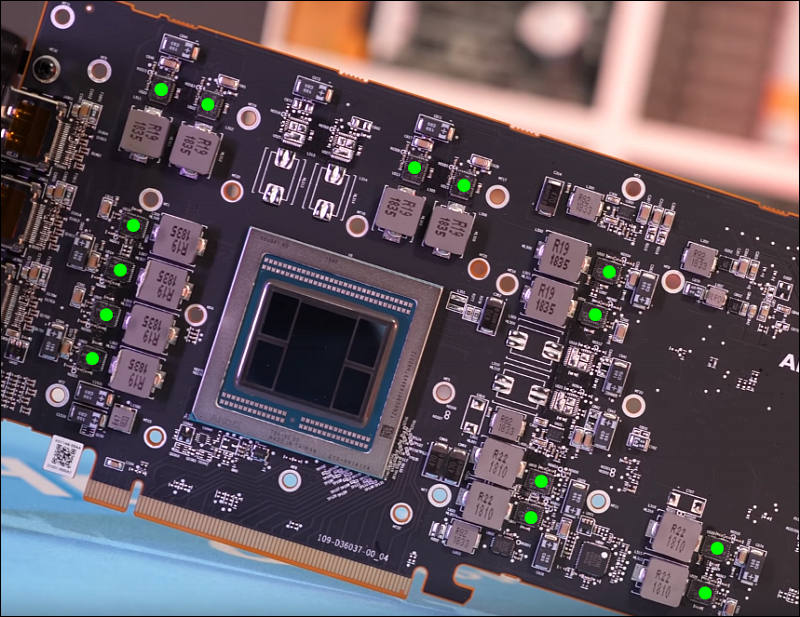
14 phases using, as it seems, IR power stages, plus few other smaller phases for stuff.
On board we see 4 phases not soldered.
All tantalum capacitors (looks like black flat things not resembling normal capacitors).

 sa6810.jpg800 x 617 - 111K
sa6810.jpg800 x 617 - 111K -
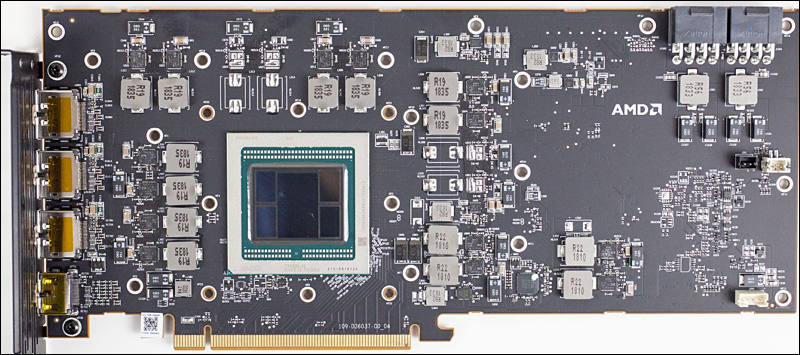
Due to HBM memory, board is really cheap and simple.
Yet AMD saved another $0.3 by removing reserve BIOS chip, so in case of any BIO update issue your card is toast.

 sa6874.jpg800 x 355 - 81K
sa6874.jpg800 x 355 - 81K -

In DaVinci Resolve we have an extensive project of more than an hour to eventually export image material as a h264 file. In it, the Radeon VII is the fastest video card, but the RX Vega 64 was also very fast and could halve the total render time of the RTX 2080.

Same strange numbers repeat.
We put together a series of tests for both Premiere Pro and Davinci Resolve exporting 8K and 4K footage into HD, with and without GPU-accelerated effects added. It's not worth showing the results, though, because the difference between the various cards was negligible. Using no GPU acceleration noticeably slowed down the exports, but the difference between our older 980 Ti and the Radeon VII was only a few seconds.
https://www.engadget.com/2019/02/07/amd-radeon-vii-review-video-4k-benchmarks/
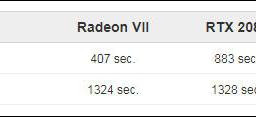
 sa6875.jpg602 x 117 - 15K
sa6875.jpg602 x 117 - 15K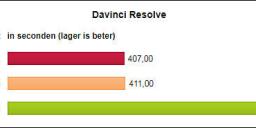
 sa6882.jpg637 x 185 - 18K
sa6882.jpg637 x 185 - 18K -
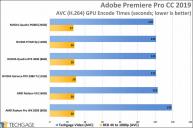
 sa6876.jpg800 x 531 - 56K
sa6876.jpg800 x 531 - 56K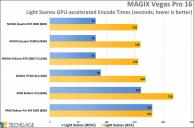
 sa6877.jpg800 x 527 - 56K
sa6877.jpg800 x 527 - 56K -
More tests



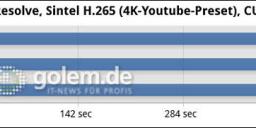
 sa6878.jpg800 x 181 - 27K
sa6878.jpg800 x 181 - 27K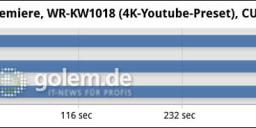
 sa6879.jpg800 x 184 - 28K
sa6879.jpg800 x 184 - 28K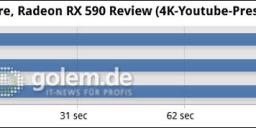
 sa6880.jpg800 x 178 - 27K
sa6880.jpg800 x 178 - 27K -
It looks like this is a beast of gpu for video editing, will upcoming lower end NAVI, be in the same league?
I need new graphics card, and NVIDIA limiting encoders was a terrible discovery for me.
Guys please share your experience in real world editing please.
Thanks all
-
I need new graphics card, and NVIDIA limiting encoders was a terrible discovery for me.
Can you tell more about "NVIDIA limiting encoders "?
Navi will be low end cards, much slower. And will be available only around one year from now.
-
Any suggestions for trouble shooting poor performance from one of these cards?
I just built up a tr1950x, asrock x399, radeon 7, 32gig ddr4 2400 box and I'm getting just mediocre performance from the MSI radeon 7. Everything else shows good results in the few tests I've done except the gpu. Rendering the 'red car test' in Vegas Pro 16 is about double the times that others are getting with lesser AMD setups. I've tried all the different drivers and think I have it set up right, but need suggestions where to look, or if I just have a dud of a card?
Cheers, Pete
-
I just built up a tr1950x, asrock x399, radeon 7, 32gig ddr4 2400 box and I'm getting just mediocre performance from the MSI radeon 7. Everything else shows good results in the few tests I've done except the gpu. Rendering the 'red car test' in Vegas Pro 16 is about double the times that others are getting with lesser AMD setups
Vegas can have no use for powerful GPU in this test. As for better results - they can have better CPU (for Vegas it can be fewer cores that are faster!_ and memory that is much faster than 2400. Most of Vegas code and routines are very ancient made for 1-2 core CPUs and with lack of parallelism in some parts.
I suggest to check in Resolve after reading how to do proper config and such.
-
That's totally incorrect @Vitaliy_Kiselev
Vegas uses multiple cores and gpu rendering for timeline performance as well or better than any other nle these days. Legacy and 3rd party fx may often be cpu single core only plugins that bottleneck vegas pro, but the base engine can use 32 or even 64 threads, with gpu acceleration to give smooth timeline playback using 4K-60p h.264 with fx applied. Even with 4K-30p h.265 hlg footage timeline playback is perfectly smooth on my machine. My issue is rendering where another guys TR1950x Vega 10 frontier edition machine shows the fastest rendering tests ever seen in vegas using Magix vce encoding (faster than an i9-9900 gtx2080ti machine using nvenc encoding even). My machine takes over twice as long with a supposedly better gpu thus my question.
I have some sort of wattman throttling going on and can't sort out where it's coming from.
Cheers, Pete
-
Vegas uses multiple cores and gpu rendering for timeline performance as well or better than any other nle these days. Legacy and 3rd party fx may often be cpu single core only plugins that bottleneck vegas pro, but the base engine can use 32 or even 64 threads
Vegas code is total nightmare, this is from talk with former developer. And in reality, outside main rendering code and encoder it have real issues with modern instructions and proper parallelism.
It is reason why they modify even basic features making them into... plugins.
Because for around 70% of Vegas code no one actually fully understand how it works, as people long time left and most of new team members are not much experienced in all this.
Yes, Magix uses their usual soft force approach with lot of freedom and not much money, but I am afraid that with present CEO it works bad as I see fast reduction of Vegas users. Get their latest announcement during NAB during private meeting that had almost no press present and where company spend more than good real stand on NAB. Personal idea of Magix CEO as he told me.My issue is rendering where another guys TR1950x Vega 10 frontier edition machine shows the fastest rendering tests ever seen in vegas using Magix vce encoding (faster than an i9-9900 gtx2080ti machine using nvenc encoding even). My machine takes over twice as long with a supposedly better gpu thus my question. I have some sort of wattman throttling going on and can't sort out where it's coming from.
Well, it is very specific thing in this case, may be Vegas just not properly recognize latest GPU features and not using most. Such things happened with Adobe products and Nvidia cards before.
-
Can you tell more about "NVIDIA limiting encoders "?
I found a way to remove that limit, no problems for about 3 months of use https://github.com/keylase/nvidia-patch
Howdy, Stranger!
It looks like you're new here. If you want to get involved, click one of these buttons!
Categories
- Topics List23,995
- Blog5,725
- General and News1,358
- Hacks and Patches1,153
- ↳ Top Settings33
- ↳ Beginners255
- ↳ Archives402
- ↳ Hacks News and Development56
- Cameras2,363
- ↳ Panasonic991
- ↳ Canon118
- ↳ Sony156
- ↳ Nikon96
- ↳ Pentax and Samsung70
- ↳ Olympus and Fujifilm100
- ↳ Compacts and Camcorders300
- ↳ Smartphones for video97
- ↳ Pro Video Cameras191
- ↳ BlackMagic and other raw cameras117
- Skill1,961
- ↳ Business and distribution66
- ↳ Preparation, scripts and legal38
- ↳ Art149
- ↳ Import, Convert, Exporting291
- ↳ Editors191
- ↳ Effects and stunts115
- ↳ Color grading197
- ↳ Sound and Music280
- ↳ Lighting96
- ↳ Software and storage tips267
- Gear5,416
- ↳ Filters, Adapters, Matte boxes344
- ↳ Lenses1,579
- ↳ Follow focus and gears93
- ↳ Sound498
- ↳ Lighting gear314
- ↳ Camera movement230
- ↳ Gimbals and copters302
- ↳ Rigs and related stuff273
- ↳ Power solutions83
- ↳ Monitors and viewfinders340
- ↳ Tripods and fluid heads139
- ↳ Storage286
- ↳ Computers and studio gear560
- ↳ VR and 3D248
- Showcase1,859
- Marketplace2,834
- Offtopic1,326


